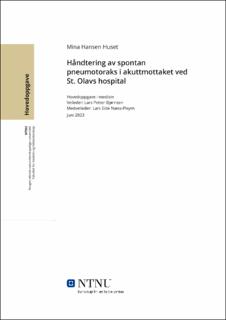| dc.contributor.advisor | Bjørnsen, Lars Petter | |
| dc.contributor.advisor | Næss-Pleym, Lars Eide | |
| dc.contributor.author | Huset, Mina Hansen | |
| dc.date.accessioned | 2023-09-23T17:19:52Z | |
| dc.date.available | 2023-09-23T17:19:52Z | |
| dc.date.issued | 2023 | |
| dc.identifier | no.ntnu:inspera:147064819:34119510 | |
| dc.identifier.uri | https://hdl.handle.net/11250/3091518 | |
| dc.description.abstract | Bakgrunn: Spontan pneumotoraks er en hyppig tilstand blant visse pasientgrupper. I Norge finnes det ingen felles retningslinjer for håndtering av spontan pneumotoraks i akuttmottak. Det finnes imidlertid flere studier som har dannet grunnlag for internasjonale retningslinjer. Denne oppgaven undersøker hvordan pasienter med diagnosen spontan pneumotoraks håndteres i akuttmottaket ved St. Olavs hospital, og hvorvidt disse retningslinjene etterleves.
Metode: Studien er en deskriptiv undersøkelse basert på retrospektive data fra pasienter som kom til akuttmottaket ved St. Olavs hospital med ICD 10-diagnosen J93, spontan pneumotoraks, mellom 1. november 2017 og 31. oktober 2022. Etter en ekskluderingsprosess ble data fra totalt 164 pasienter inkludert i studien. For å undersøke håndteringen av pasientene, ble et sett med variabler definert. Blant disse var logistiske, kliniske og diagnostiske variabler, samt variabler som beskriver hvilke tiltak som ble startet for behandling av tilstanden.
Resultater: Flertallet av pasientene i studien var menn, og det var en overvekt av primær spontan pneumotoraks. Det var en signifikant forskjell mellom kjønn og type pneumotoraks, der primær spontan pneumotoraks var vanligst blant menn og sekundær var vanligst blant kvinner. Det var også en betydelig forskjell i alder mellom primær og sekundær spontan pneumotoraks, med en overvekt av primær type hos de yngste, og sekundær hos de eldste. De fleste pasientene fikk utført en røntgen toraks for diagnostikk, og et mindretall ble undersøkt med ultralyd eller CT. Flere av pasientene fikk ikke oksygenbehandling i tråd med retningslinjene, særlig blant de med primær pneumotoraks. Det var også diskrepans mellom retningslinjene og praksis når det gjaldt innleggelser.
Konklusjon: Studien gir nyttig innsikt i hvordan håndteringen av pasienter med spontan pneumotoraks i akuttmottaket ved St. Olavs hospital kan forbedres. Kjønnsfordelingen viste seg å ha en signifikant sammenheng med type pneumotoraks, noe som kan ha kliniske konsekvenser. Her kan videre forskning være nyttig for å undersøke hvordan dette påvirker behandlingsvalg og prognose. Ettersom røntgen toraks er den vanligste bildediagnostiske metoden for diagnostikk av pneumotoraks, er ultralyd mindre utbredt. Studier viser gode resultater ved bruk av ultralyd, og mer erfaring vil være nyttig for å kunne utnytte denne metoden ytterligere. Resultatene viser at det er rom for bedring når det kommer til etterlevelse av retningslinjer for oksygenbehandling og innleggelse. Økt bevisstgjøring rundt dette kan blant annet bidra til et kortere og mer skånsomt behandlingsløp for pasienten. | |
| dc.description.abstract | Background: Spontaneous pneumothorax is a common condition among certain patient groups. In Norway, there are no unified guidelines for the management of spontaneous pneumothorax in emergency departments. However, several studies have formed the basis of international guidelines. This study examines how patients diagnosed with spontaneous pneumothorax are managed in the emergency department at St. Olav’s Hospital and whether these guidelines are followed.
Method: This is a descriptive study based on retrospective data from patients who presented to the emergency department at St. Olav’s Hospital with the ICD-10 diagnosis J93, spontaneous pneumothorax, between November 1, 2017, and October 31, 2022. After an exclusion process, data from a total of 164 patients were included in the study. To examine the management of the patients, a set of variables was defined. These included logistical and clinical variables, diagnostic variables, and variables describing the actions initiated for the treatment of the condition.
Results: Most of the patients in the study were male, and there was a predominance of primary spontaneous pneumothorax. There is a significant association between gender and type of pneumothorax, with primary spontaneous pneumothorax being more common among men and secondary spontaneous pneumothorax being more common among women. There was also a significant age difference between primary and secondary spontaneous pneumothorax. The majority of patients underwent chest X-ray for diagnosis, while a minority were examined with ultrasound or CT. Several patients did not receive oxygen treatment in accordance with the guidelines, especially among those with primary pneumothorax. There was also a discrepancy between the guidelines and practice regarding hospital admissions.
Conclusions: The study provides valuable insight into how the management of patients with spontaneous pneumothorax in the emergency department at St. Olav’s Hospital can be improved. The gender distribution was found to have a significant association with the type of pneumothorax, which may have clinical implications. Further research could be useful in investigating how this affects treatment and prognosis. As chest X-ray is the most common imaging method for diagnosing pneumothorax, ultrasound is less widespread. Studies show promising results with the use of ultrasound, and more practice and experience would be beneficial in further utilizing this method. The results indicate room for improvement in adherence to guidelines for oxygen treatment and hospital admissions. Increased awareness of this issue can contribute to a shorter and more gentle treatment course for the patients. | |
| dc.language | nob | |
| dc.publisher | NTNU | |
| dc.title | Håndtering av spontan pneumotoraks i akuttmottaket ved St. Olavs hospital | |
| dc.type | Master thesis | |
